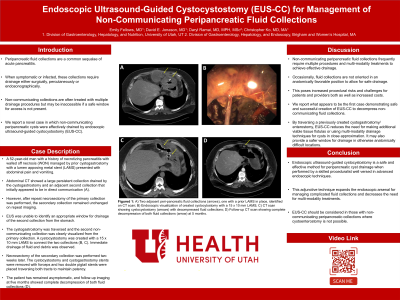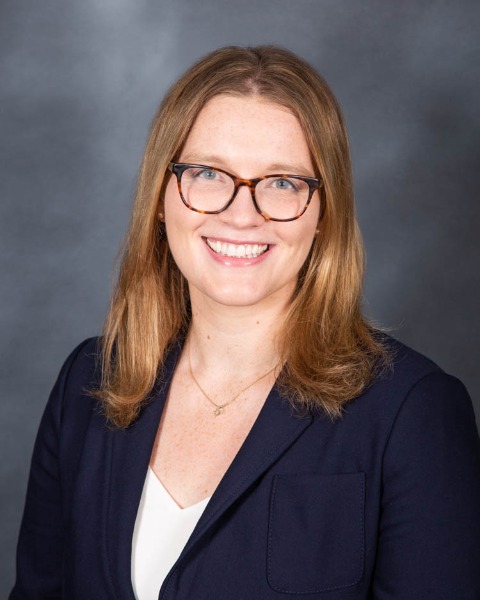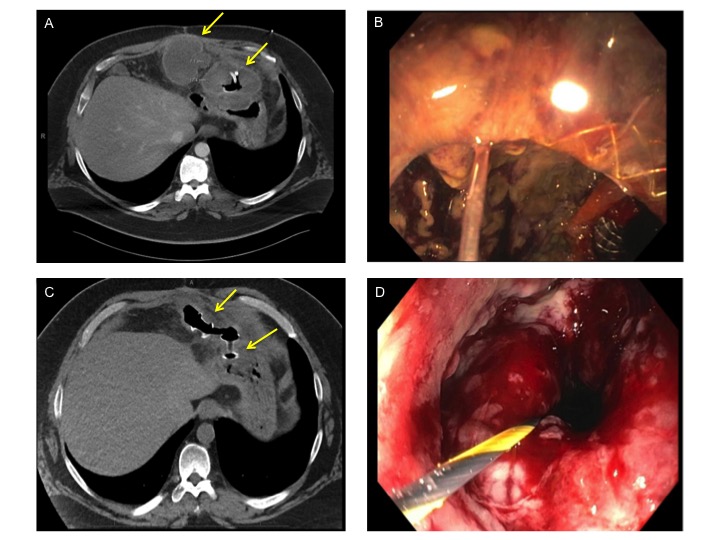Monday Poster Session
Category: Interventional Endoscopy
P2843 - Endoscopic Ultrasound-Guided Cystocystostomy (EUS-CC) for Management of Non-Communicating Peripancreatic Fluid Collections
Monday, October 28, 2024
10:30 AM - 4:00 PM ET
Location: Exhibit Hall E

Has Audio

Emily Fellows, MD
University of Utah
Salt Lake City, UT
Presenting Author(s)
Emily Fellows, MD1, David Jonason, MD1, Gregory Toy, MD1, Daryl Ramai, MD, MPH, Msc2, Jay DuBroff, MD, MPH1, Christopher Ko, MD, MA1
1University of Utah, Salt Lake City, UT; 2University of Utah Health, Salt Lake City, UT
Introduction: Peripancreatic fluid collections are a common sequelae of pancreatitis and when symptomatic or infected, require drainage surgically, percutaneously or endosonographically. Non-communicating collections are often treated with multiple drainage procedures but may be inaccessible if an access window is not present. We report a novel case in which non-communicating cysts were effectively drained by endoscopic ultrasound-guided cystocystostomy (EUS-CC).
Case Description/Methods: A 52-year-old male with a history of necrotizing pancreatitis with walled-off necrosis and prior cystogastrostomy with a 20 x 10 mm lumen-apposing metal stent (LAMS) presented with abdominal pain and vomiting. Abdominal CT scan showed a large persistent collection drained by cystogastrostomy. An adjacent second collection in close proximity was noted (Fig. 1a). EGD with necrosectomy of the primary collection was performed, but the secondary collection was unchanged in size on repeat imaging. EUS was unable to identify an appropriate window for drainage from the stomach. A window was obtained by traversing the cystogastrostomy into the primary collection where the second, non-communicating collection was visualized. The decision was made to create a cystocystostomy. After confirming no interposing vessels, a 15 x 10 mm LAMS using electrocautery was advanced into the secondary collection and deployed connecting the two collections (Fig. 1b, c). The stent was balloon dilated to 12 mm. Drainage of fluid and debris was immediate. Repeat EGD with necrosectomy of the secondary collection was performed two weeks later with complete decompression of both cysts. The cystocystostomy stent was then removed with forceps followed by the cystogastrostomy stent, and two double pigtail stents were placed traversing both tracts to maintain patency (Fig. 1d). He has remained asymptomatic and follow-up imaging continues to show complete decompression of both cysts.
Discussion: Non-communicating peripancreatic fluid collections frequently require multiple procedures and even multi-modality treatments to achieve effective drainage, posing increased procedural risks and challenges for patients and providers. We report what appears to be the first case demonstrating safe and successful creation of an EUS-CC to drain two non-communicating collections. This unique adjunctive technique expands endosonographic options for peripancreatic cyst drainage and should be considered in those with non-communicating collections with favorable windows.

Disclosures:
Emily Fellows, MD1, David Jonason, MD1, Gregory Toy, MD1, Daryl Ramai, MD, MPH, Msc2, Jay DuBroff, MD, MPH1, Christopher Ko, MD, MA1. P2843 - Endoscopic Ultrasound-Guided Cystocystostomy (EUS-CC) for Management of Non-Communicating Peripancreatic Fluid Collections, ACG 2024 Annual Scientific Meeting Abstracts. Philadelphia, PA: American College of Gastroenterology.
1University of Utah, Salt Lake City, UT; 2University of Utah Health, Salt Lake City, UT
Introduction: Peripancreatic fluid collections are a common sequelae of pancreatitis and when symptomatic or infected, require drainage surgically, percutaneously or endosonographically. Non-communicating collections are often treated with multiple drainage procedures but may be inaccessible if an access window is not present. We report a novel case in which non-communicating cysts were effectively drained by endoscopic ultrasound-guided cystocystostomy (EUS-CC).
Case Description/Methods: A 52-year-old male with a history of necrotizing pancreatitis with walled-off necrosis and prior cystogastrostomy with a 20 x 10 mm lumen-apposing metal stent (LAMS) presented with abdominal pain and vomiting. Abdominal CT scan showed a large persistent collection drained by cystogastrostomy. An adjacent second collection in close proximity was noted (Fig. 1a). EGD with necrosectomy of the primary collection was performed, but the secondary collection was unchanged in size on repeat imaging. EUS was unable to identify an appropriate window for drainage from the stomach. A window was obtained by traversing the cystogastrostomy into the primary collection where the second, non-communicating collection was visualized. The decision was made to create a cystocystostomy. After confirming no interposing vessels, a 15 x 10 mm LAMS using electrocautery was advanced into the secondary collection and deployed connecting the two collections (Fig. 1b, c). The stent was balloon dilated to 12 mm. Drainage of fluid and debris was immediate. Repeat EGD with necrosectomy of the secondary collection was performed two weeks later with complete decompression of both cysts. The cystocystostomy stent was then removed with forceps followed by the cystogastrostomy stent, and two double pigtail stents were placed traversing both tracts to maintain patency (Fig. 1d). He has remained asymptomatic and follow-up imaging continues to show complete decompression of both cysts.
Discussion: Non-communicating peripancreatic fluid collections frequently require multiple procedures and even multi-modality treatments to achieve effective drainage, posing increased procedural risks and challenges for patients and providers. We report what appears to be the first case demonstrating safe and successful creation of an EUS-CC to drain two non-communicating collections. This unique adjunctive technique expands endosonographic options for peripancreatic cyst drainage and should be considered in those with non-communicating collections with favorable windows.

Figure: Figure 1: (A) Abdominal CT scan identifying two fluid collections within the left and right superior peripancreatic spaces, one with a prior cystogastrostomy with LAMS; (B) Endoscopic imaging showing successful cystocystostomy with LAMS visualized through the prior cystogastrostomy LAMS; (C) Abdominal CT scan demonstrating near complete resolution of the two collections following cystocystostomy; (D) Endoscopic imaging showing both tracts following removal of the cystocystostomy and cystogastrostomy LAMS.
Disclosures:
Emily Fellows indicated no relevant financial relationships.
David Jonason indicated no relevant financial relationships.
Gregory Toy indicated no relevant financial relationships.
Daryl Ramai indicated no relevant financial relationships.
Jay DuBroff indicated no relevant financial relationships.
Christopher Ko indicated no relevant financial relationships.
Emily Fellows, MD1, David Jonason, MD1, Gregory Toy, MD1, Daryl Ramai, MD, MPH, Msc2, Jay DuBroff, MD, MPH1, Christopher Ko, MD, MA1. P2843 - Endoscopic Ultrasound-Guided Cystocystostomy (EUS-CC) for Management of Non-Communicating Peripancreatic Fluid Collections, ACG 2024 Annual Scientific Meeting Abstracts. Philadelphia, PA: American College of Gastroenterology.
